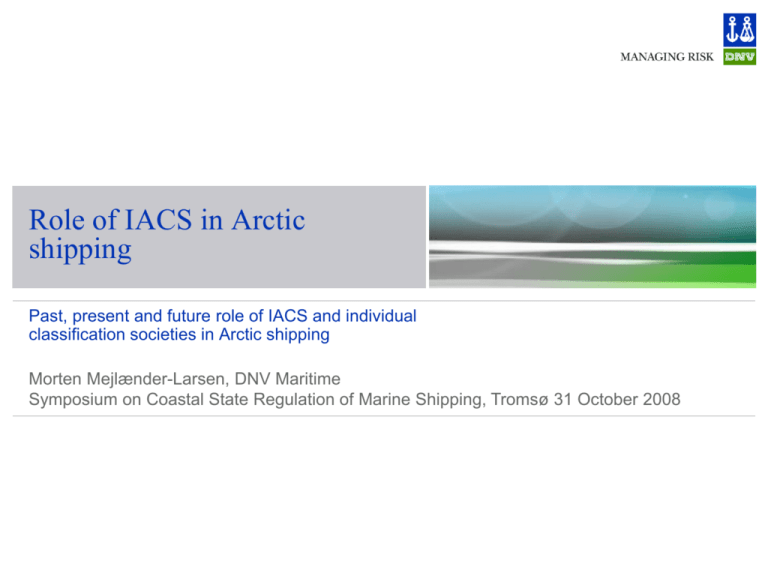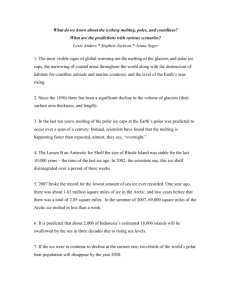
Role of IACS in Arctic
shipping
Past, present and future role of IACS and individual
classification societies in Arctic shipping
Morten Mejlænder-Larsen, DNV Maritime
Symposium on Coastal State Regulation of Marine Shipping, Tromsø 31 October 2008
Content
DNV focus on Arctic
The Class Concept
IMO Guideline for ships operating in
Arctic ice-covered waters
IACS
- IACS organisation
- Relation between Class Societies and
IACS
- Implementation of IACS Unified
Polar Rules
© Det Norske Veritas AS. All rights reserved
16 March 2016
Slide 2
DNV-Arctic Focus
25% of known oil and gas resources
located in the cold areas
Russia has become the largest
exporter of oil and a major exporter of
gas
Increased export of oil and minerals
from ice infested waters
Ship operations in Cold Climate will
require:
© Photo Arnstein Moen
- specially designed ships and
equipment
- crew with experience
Implementation of Polar Class rules,
referred to in the IMO Guideline
© Det Norske Veritas AS. All rights reserved
16 March 2016
Slide 3
R=PxC
North Sea/World wide
Arctic
R
R
Ex. Maritime Risk:
Grounding
Collision with other vessel
Collision with installation
Contact
Fire/explosion
Collision during Ship To Ship (STS)
approach
Structural failure
Accidental oil spill during loading/unloading
© Det Norske Veritas AS. All rights reserved
Additional risk
16 March 2016
Slide 4
The ice is melting.....
-but less ice, higher risk
Year- round
Navigation
Suez
Canal
Distance (Nautical Miles) Hamburg to
Yokohama:
Northern Sea Route ~ 6,920
Suez Canal ~ 11,073
Panama Canal ~ 12,420
Cape of Good Hope ~ 14,542
Strait of Malacca
INSROP (1999)
Slide 5
Ice Rule Development in DNV
1871, §19 First Rules including
requirements for ice-reinforcement:
- Frames: Additional frames in the bow
region.
- Plate thickness: Increased thickness in
bow
1960, Several ice classes introduced, in
conformity with Finnish-Swedish ice
regulations
1988, Rules for ”Vessels for Arctic and
Icebreaking Service” implemented into
the DNV Rules for Classification of
Ships
2008, Polar Classes implemented into
the DNV Rules for Classification of
Ships, based on IACS Unified
Requirements for Polar Ships
•”Fram” was built to survive arctic drift by Fridtjof Nansen,
who used the ship on his expedition 1893 to 1896.
© Det Norske Veritas AS. All rights reserved
16 March 2016
Slide 6
Scope of classification
Based on published rules,
the classification process
consists of:
Approval of design
Attendance at the construction to
verify that the vessel is constructed in
accordance with the classification
rules
Upon satisfactory completion of the
above, a certificate of classification
will be issued
© Det Norske Veritas AS. All rights reserved
16 March 2016
Slide 7
Scope of classification
Once in service, periodical class
surveys are carried out
Class rules do not cover every
piece of structure or item of
equipment on board a vessel, nor
do they cover operational
elements.
© Det Norske Veritas AS. All rights reserved
16 March 2016
Slide 8
DNV classification services in Cold Climate
Mandatory
Class/Statutory
(basic)
Normally
required
Ice Class
Baltic/Arctic
WINTERIZED ARCTIC (material °C, extreme °C)
Built to ARCTIC or ICEBREAKER class
Requirements to CP propeller, or diesel/electric
Two engine rooms for Power, AUX, and heating
Helicopter landing facilities
Life saving and navigation equip certified for low
Human
factors
Comfort
class
- Noise
- Vibrations
- Indoor climate
temperatures
WINTERIZED COLD (material °C, extreme °C)
Hull strength/fatigue
Corrosion
Coating
Machinery
SOLAS/MARPOL/LL
Ice strengthening
- Rudder/ stock
- Hull
- Propeller/ shaft
ME output
Sea chest arr.
Ballast water anti
freezing
Built to BALTIC or ARCTIC ice class
Requirements to location of safety equipment
Requirements to steel grades, DAT(-xx) notation
WINTERIZED BASIC
Arrangements
for anti-icing and de-icing
Heating of spaces with important equipment
Arrangements and location of generator
capacity
© Det Norske Veritas AS. All rights reserved
16 March 2016
Slide 9
Winterisation
Hydro
Winterisation for health
- Physical effects such as fatigue,
frostbite, hypothermia
Winterisation for safety
- Safety-critical equipment and
systems
Winterisation for operability
- Systems to maintain the
functionality of desired operations
© Det Norske Veritas AS. All rights reserved
16 March 2016
Slide 10
IMO Guidelines for Ships Operating in Arctic
Ice-Covered Waters
Prompted by the disaster of Exxon Valdez
(1989), IMO started working on a unified code
for navigation in polar waters
Goal: Harmonize regulations for Arctic
Shipping in polar waters
In 2002 the Marine Safety Committee (MSC)
and the Marine Environment Committee
(MEPC) approved Guidelines for ships
operating in Arctic ice-covered waters
(MSC/Circ.1056 –MEPC/Circ.399).
Still voluntary, however the guideline represent
an important step towards improved regulatory
framework for shipping in ice-infested waters
© Det Norske Veritas AS. All rights reserved
16 March 2016
Slide 11
The IMO Arctic Guidelines
PART A: Construction provisions
- Structures (reference to IACS Unified Requirements for Polar ships)
- Substructures and stability
- Accommodation and escape measures
- Directional control systems
- Anchoring and towing arrangements
- Main machinery
- Auxiliary machinery systems
- Electrical installations
PART B: Equipment
- Fire fighting
- Life saving appliances
- Navigational equipments
PART C: Operational
- Operational guidelines
- Crewing
- Emergency equipment
PART D Environmental protection and damage control
- Environmental protection and damage control
© Det Norske Veritas AS. All rights reserved
16 March 2016
Slide 12
IACS Unified Requirements UR I1-I3
UR I1
-
Specify application of structural and machinery requirements
-
Provide descriptions of polar classes to convey differences with respect to operational capability and strength
-
No requirements included in UR I1
-
Applicable to any ship opeating in ice-infested polar waters, including Icebreakers
UR I2
-
Structural requirements to enable polar class ships to withstand global and local ice
loads, as well as temperature, characteristic of their polar class
-
Plating, framing, plated structures and hull girder
-
Material requirements, corrosion/abrasion allowances
-
Hull appendages, stem and stern frames
UR I3
-
Propeller ice interaction loads
-
Structural requirements for propeller, machinery components and system
Implemented into DNV Rules from March 2008
© Det Norske Veritas AS. All rights reserved
16 March 2016
Slide 13
IACS
International Association of Classification Societies
Dedicated to safe ships and clean seas, IACS members make a
unique contribution to maritime safety and regulation through
technical support, compliance verification and research and
development.
More than 90% of the world's cargo carrying tonnage is covered by
the classification design, construction and through-life compliance
rules and standards set by the ten Member Societies and one
Associate of IACS.
© Det Norske Veritas AS. All rights reserved
16 March 2016
Slide 14
IACS Member Societies
© Det Norske Veritas AS. All rights reserved
16 March 2016
Slide 15
IACS organisation chart
IACS Council
EG/LAW
EG/GBS
Permanent Secretariat
Quality Secretariat
Quality Committee
General Policy Group
EG/FSA
EG/NCSR
Hull Panel
EG/Data
EG/Coating
Machinery Panel
Statutory Panel
EG/ILO
On hold, until
further notice
Survey Panel
EG/ISM ISPS
Project team
© Det Norske Veritas AS. All rights reserved
Project team
Project team
16 March 2016
Project team
Slide 16
IACS bodies explained
Council
- The Council is the political governing body
of the Association and consists of one
representative of each Member Society.
Panels
- A Permanent working group established by
Council or GPG related to specific areas of
the technical work of classification societies.
Project Team
- A temporary working group established
under a Panel to deal with specific tasks.
Quality Committee
- Is the governing body of the Quality System
Certification Scheme.
- The Quality Committee shall consist of one
representative from each Member.
Quality Secretariat
- Responsible for the assessment of each
member with respect to compliance with
QSCS.
© Det Norske Veritas AS. All rights reserved
Expert Groups [EG]
- A working group, established by Council or
GPG to advise on a specialised area of
work of classification societies.
Permanent Secretariat
- Provides administrative support to the
members and management support to the
Chair
Permanent Secretary
- Is the chief administrative officer of the
Association and shall be responsible for the
efficient day to day running of the
Permanent Secretariat
- A working group, established by Council to
deal with a specific task.
General Policy Group [GPG]
- The GPG is the technical governing body of
the Association and consists of one
representative of each Member Society
Small Groups [SG]
16 March 2016
Slide 17
Areas of competence of IACS Panels
Hull Panel
Strength
Materials/Welding
Wave data/Sea loads
DSA
Drilling units
Polar ships
Hull damage
Containers
Mooring/Anchoring
RoRo Safety
Note 1:
Note 2:
Note 3:
Machinery Panel
Statutory Panel
Survey Panel
Machinery
Electric systems
Computers
Polar Ship Machinery
Subdivision, stability
and load lines
Fire protection and
safety
Bulk liquid, gases
and marine pollution
Exhaust emission
control
ISM Code
ISPS
Life saving
appliances
Bridge equipment etc.
ILO
Survey, reporting
and certification
Certification of
materials and
equipment
New construction
survey requirements
PR 1A (ToC)
PR 2 (EWS)
Each Panel is composed of one member from each Society
Panel Chairmen participate in some GPG meetings
Panel Chairmen and their secretariats are financed by IACS members
© Det Norske Veritas AS. All rights reserved
16 March 2016
Slide 18
GUIDELINES FOR SHIPS OPERATING
IN ARCTIC ICE-COVERED WATERS
© Det Norske Veritas AS. All rights reserved
16 March 2016
Slide 19
Ice Class Notations
Baltic
Polar Class
PC1
Year-round operation in all Polar waters
PC2
Year-round operation in moderate multi-year ice
conditions
PC3
Year-round operation in second-year ice which
may include multi-year inclusions
PC4
Year-round operation in thick first-year ice which
may include old ice inclusions
PC5
Year-round operation in medium first-year ice
which may include old ice inclusions
1.0 m first year
ice
ICE-1A*
PC6
Summer/autumn operation in medium first-year
ice which may include old ice inclusions
0.8 m first year
ice
ICE-1A
PC7
Summer/autumn operation in thin first-year ice
which may include old ice inclusions
0.6 m first year
ice
ICE-1B
0.4 m first year
ice
ICE-1C
© Det Norske Veritas AS. All rights reserved
-PC1 to PC6 may be assigned additional notation ICEBREAKER
16 March 2016
Slide 20
Ice Class Notations
KV Svalbard
Baltic
Polar Class
PC1
Year-round operation in all Polar waters
PC2
Year-round operation in moderate multi-year ice
conditions
PC3
Year-round operation in second-year ice which
may include multi-year inclusions
PC4
Year-round operation in thick first-year ice which
may include old ice inclusions
Photo: FMA
PC5
Year-round operation in medium first-year ice
which may include old ice inclusions
1.0 m first year
ice
ICE-1A*
PC6
Summer/autumn operation in medium first-year
ice which may include old ice inclusions
0.8 m first year
ice
ICE-1A
PC7
Summer/autumn operation in thin first-year ice
which may include old ice inclusions
0.6 m first year
ice
ICE-1B
0.4 m first year
ice
ICE-1C
© Det Norske Veritas AS. All rights reserved
Photo: Silja Line
MS NordNorge
-PC1 to PC6 may be assigned additional notation ICEBREAKER
16 March 2016
Slide 21
Ice Class Notations
Baltic
Polar Class
PC1
Year-round operation in all Polar waters
PC2
Year-round operation in moderate multi-year ice
conditions
PC3
Year-round operation in second-year ice which
may include multi-year inclusions
PC4
Year-round operation in thick first-year ice which
may include old ice inclusions
PC5
Year-round operation in medium first-year ice
which may include old ice inclusions
1.0 m first year
ice
ICE-1A*
PC6
Summer/autumn operation in medium first-year
ice which may include old ice inclusions
0.8 m first year
ice
ICE-1A
PC7
Summer/autumn operation in thin first-year ice
which may include old ice inclusions
0.6 m first year
ice
ICE-1B
0.4 m first year
ice
ICE-1C
© Det Norske Veritas AS. All rights reserved
-PC1 to PC6 may be assigned additional notation ICEBREAKER
16 March 2016
Slide 22
Ship-shaped offshore units
Mobile Offshore Units
Floating
Offshore
Drill and production ships
Floating production
FPSO, FSO
Offshore
Stena
Prirazlomnoye
© Det Norske Veritas AS. All rights reserved
Ship
16 March 2016
StatoilHydro
Slide 23
DNV is a global provider of services for managing risk.
Established in 1864, DNV is an independent foundation with
the objective of safeguarding life, property and the
environment.
DNV comprises 300 offices in 100 countries, with 8000
employees.
© Det Norske Veritas AS. All rights reserved
16 March 2016
www.dnv.com
Slide 24







